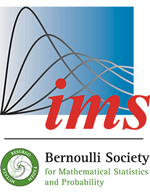Abstract
A random walk in a sparse random environment is a model introduced by Matzavinos et al. [Electron. J. Probab. 21, paper no. 72: 2016] as a generalization of both a simple symmetric random walk and a classical random walk in a random environment. A random walk $(X_{n})_{n\in \mathbb{N} \cup \{0\}}$ in a sparse random environment $(S_{k},\lambda _{k})_{k\in \mathbb{Z} }$ is a nearest neighbor random walk on $\mathbb{Z} $ that jumps to the left or to the right with probability $1/2$ from every point of $\mathbb{Z} \setminus \{\ldots ,S_{-1},S_{0}=0,S_{1},\ldots \}$ and jumps to the right (left) with the random probability $\lambda _{k+1}$ ($1-\lambda _{k+1}$) from the point $S_{k}$, $k\in \mathbb{Z} $. Assuming that $(S_{k}-S_{k-1},\lambda _{k})_{k\in \mathbb{Z} }$ are independent copies of a random vector $(\xi ,\lambda )\in \mathbb{N} \times (0,1)$ and the mean $\mathbb{E} \xi $ is finite (moderate sparsity) we obtain stable limit laws for $X_{n}$, properly normalized and centered, as $n\to \infty $. While the case $\xi \leq M$ a.s. for some deterministic $M>0$ (weak sparsity) was analyzed by Matzavinos et al., the case $\mathbb{E} \xi =\infty $ (strong sparsity) will be analyzed in a forthcoming paper.
Citation
Dariusz Buraczewski. Piotr Dyszewski. Alexander Iksanov. Alexander Marynych. Alexander Roitershtein. "Random walks in a moderately sparse random environment." Electron. J. Probab. 24 1 - 44, 2019. https://doi.org/10.1214/19-EJP330
Information





